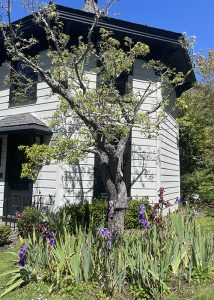Creating an inviting environment to attract pollinators is a surefire way to ensure you’re getting the maximum yield in your vegetable garden. Honeybees are only the most familiar member of the huge family of bees and wasps, there are many others that play an essential role in pollination. While for many of us, it doesn’t take news of giant “murder hornets” for panic to set in when a buzzing yellow insect flies into view, the good these creatures do in the garden is something we can all appreciate—from a distance.
Did you know that tomatoes as well as their relatives, eggplants and peppers, are not pollinated by honeybees? Their flowers are built for a particular kind of bee pollination called buzz pollination, which requires native bees like bumblebees (Bombus spp.) and mud bees (Anthophora urbana).
Bumblebees and mud bees land on the bottom of the downward-pointing flower, grasping its pollen-producing anther cone with their legs and the pointed end of the cone resting against their abdomen. They then vibrate their wing muscles—you can hear an audible buzz when they do this. This shakes the pollen down the anther tube, releasing it to land on the flower’s own stigma where it germinates, and the bee. If it is a short-styled flower, it becomes self-pollinated. If it is a long-styled flower, the stigma presses against the bee’s body where it can be cross-pollinated with pollen from other plants.
Bumblebees are robust, hairy, black-and-yellow bees with dark wings. Some species have a red color on their abdomens. They are more solitary than honeybees: the queen bumblebee overwinters in a protected area and finds a nesting site in spring, usually an old mouse nest or a burrow, and begins the nest herself. The bees are able to find the burrows by honing in on the scent of its former rodent inhabitants. If you have old rodent burrows, do not fill them all in; leave a few open for the bumbles and you’ll have better odds for your tomato crop.
Mud bees are smaller than a honeybee and black, gray and white. They build nests underground in flat, bare soil areas or in vertical banks of soil. Where conditions are right, hundreds of females congregate and make their nests. Mud bees have a higher-pitched vibrating buzz than bumblebees and are faster fliers than bumblebees or honeybees, so it’s often hard to get a good look at them.
Honeybees are unable to buzz-pollinate tomato flowers; since they aren’t equipped to shake the pollen free from the anthers, there’s no reason for them to visit the flowers because there is no nectar reward. You will definitely want to attract honeybees if you are growing fruit or other “fruiting” vegetables like cucumbers, summer squash and/or winter squash, though. There are a few tricks to entice more honeybees to your vegetable garden and give them a reason to return over and over. Planting herbs among your veggies attracts bees when they flower. Some good varieties are thyme, oregano, savory, and ornamental basil. Adding edible flowers such as calendula, violas and marigolds will also attract honeybees, as well as being pretty little tasty additions to your salads.
Mason bees pollinate many of the same plants as honeybees. They are tunnel-nesting, solitary bees, which means that unlike the social honeybee, every female is a queen who lays eggs and raises offspring on her own, without the support of a highly-organized, social colony. They are non-aggressive and rarely sting. These bees lay their eggs inside existing tunnels, such as those left by wood-boring beetles or in the hollow stems of pithy plants. Luckily, mason bees also nest in human-made tunnels—if the tunnel meets certain criteria.

Perhaps you’ve seen these shallow boxes filled with hollow wooden or bamboo tubes. You can purchase a bee box from many nurseries or garden centers and the Mason Bees will set up house in your garden.
One last tip for attracting pollinators is to plant summer blooming native plants like native varieties of milkweed, yarrow and buckwheat. These will attract the native into your garden where they will undoubtedly find your vegetables and help bolster their populations as well.




